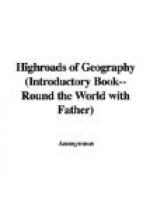4. Write out and learn: A volcano is a hole in the ground out of which steam, ashes, mud, and melted rock are thrown. An earthquake is a shaking or tearing apart of the ground.
Lesson 23.
1. Which should you prefer to be—a boy or a girl (1) in Japan, (2) in India?
2. Describe the picture on page 90 {Illustration entitled “The Toy Seller"}.
3. Try to make a drawing of a kite just after its string has been cut by the glass on the string of another kite.
Lesson 24.
1. Write out and learn: A plain is a wide tract of low-lying and nearly level country. A high plain is called a plateau.
[Illustration: {Salmon}]
2. Copy this drawing of a salmon. What do you know about salmon?
3. Which should you like to do best—till the fields, cut down trees, or catch salmon? Say why.
Lesson 25.
1. Describe the picture on page 105 {Illustration entitled “Boys of Canada in Winter"}. Why do the boys cover up their ears?
2. What sports do these boys enjoy in winter?
[Illustration: {Canoe}]
3. Copy this drawing of a canoe.
Lesson 26.
[Illustration: {Wigwam}]
1. Copy this little drawing of a wigwam—that is, a Red man’s tent.
2. Describe the picture on page 102 {Illustration entitled “Red Men and White Men"}.
3. How did the Red men hunt the bison? What has become of the bison?
Lesson 27.
1. Look carefully at the picture on page 111 {Illustration entitled “Amongst the Eskimos"}. Compare it with the picture on page 35 {Illustration entitled “Arabs of the Desert"}.
2. Why are the Eskimos fishermen and hunters, and not farmers?
3. How would you build a snow house? Would it be very cold to live in? If not, why not?
Lesson 28.
1. Describe the picture on page 102 {Illustration entitled “Red Men and White Men"}.
2. Write out the following: “The cotton plant loves sun and water, and will only grow in the hot, moist parts of the world. It throws out flower stalks, at the end of which pods appear. Inside the pods is a soft, white down, which is called cotton. This is spun and woven into cloth.”
3. What is the difference between cotton and wool?
Lesson 29.
1. Look at a globe. Find a line running round the globe at the thickest part. This is called the Equator, because it divides the earth into two equal parts. The hottest parts of the earth lie round about the Equator. The distance round the earth at the Equator is 25,000 miles. A railway train, running 50 miles an hour, and never stopping, would require nearly three weeks for the journey. Find out whether father’s voyage was longer or shorter than this.
2. Measure with a band of paper the distance on the globe from the Equator on one side to the Equator on the other. Find half this distance and mark it on the globe. Then mark the same distance on the other side of the Equator. The points which you have marked are called the Poles. One is the North Pole; the other is the South Pole.




